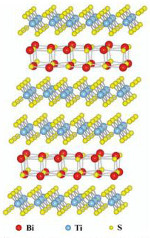EPJB Review - New promising bulk thermoelectrics
- Details
- Published on 11 March 2014

The growing need for alternative “green” energy sources has prompted renewed interest in thermoelectric materials. These materials can directly convert heat to electricity or, conversely, use electrical current to cool. The thermoelectric performance of a material can be estimated by the so-called figure of merit, zT = σα2T/λ (α is the Seebeck coefficient, σα2 is the power factor, σ and λ are the electrical and thermal conductivity, respectively), the value of which depends only on the material.
In a new EPJ B review, authors Gonçalves and Godart discuss the state of the art in this field, with special emphasis on the strategies to reduce the lattice part of the thermal conductivity and maximize the power factor in thermoelectric materials.
In the mid-1990s the “phonon glass and electron crystal” concept was developed which, together with a better understanding of the parameters that affect zT and the use of new synthetic methods and characterisation techniques, has led to the discovery of improved bulk thermoelectric materials that are now being utilised in practical applications. During the last few decades there has been particular focus on skutterudites, clathrates, half-Heusler alloys, Si1−xGex-, Bi2Te3- and PbTe-based materials. But many other materials, in particular those based on intermetallics, pnictides, chalcogenides, oxides, etc., are now emerging as potential advanced bulk thermoelectrics.
The authors also review the most recently identified potential thermoelectric bulk materials, in particular those based on intermetallics, pnictides and chalcogenides. They conclude with a discussion of the different shaping techniques that have been used to produce bulk materials from nanostructured thermoelectric materials.
New promising bulk thermoelectrics: intermetallics, pnictides and chalcogenides. Antonio P. Gonçalves and Claude Godart (2014) Eur.Phys. J. B, DOI: 10.1140/epjb/e2014-40989-3




